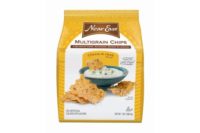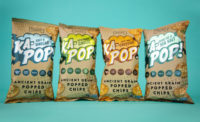A renaissance is underway in the chip category. Consumer interest in natural foods and ancient grains is influencing the category and driving growth of multigrain chips.
“Consumers are looking for wholesome and unique ingredients to both provide inherent nutrition as well as unique ingredients to fulfill their discovery,” says Keith Dalziel, marketing manager, Food Should Taste Good, General Mills, Minneapolis.
Dalziel states that there is an emphasis on ancient and whole grains like quinoa and spelt, along with seeds like flax and chia. In response, General Mills formulates Food Should Taste Good Multigrain Tortilla Chips with brown rice, flax, sunflower and sesame seeds, and quinoa. The chips also are gluten-free, vegan, kosher, low-sodium, cholesterol-free and trans-fat-free.
“We introduced our Multigrain Tortilla Chips in January 2006,” states Dalziel. “At the time, it was a one-of-a-kind offering that brought a more-wholesome chip to market, comprised of simple, wholesome ingredients you could see in the chips.”
Other Food Should Taste Good tortilla chips include Blue Corn Dipping Chips, Chocolate (semisweet chocolate and cocoa), Falafel (chickpeas, garlic and onion), Guacamole (cilantro, avocados and serrano chiles), Jalapeño with Cheddar (jalapeños, red pepper and white Cheddar), Olive (black, green and kalamata olives), Harvest Pumpkin (pumpkin, cinnamon and nutmeg), Kimchi (cabbage, onion, garlic and red bell pepper), The Works! (poppy and caraway seeds, onion and garlic—the company likens it to an everything bagel) and many more—20 varieties just in the tortilla line.
“Smaller and emerging brands like ours play a role in bringing more variety to a category that thrives on variety,” says Dalziel. “We are committed to providing a line of chips that allows our consumers to explore different culinary experiences.”
In consumers’ busy day-to-day lives, sometimes there isn’t time for a meal, only a snack, which means every bite counts. So more snack manufacturers have grown committed to making each bite as healthful as possible, while still satisfying that craving for a crunchy, salty snack.
“Consumers in the natural and organic marketplace have moved beyond corn chips in search of nuts, seeds and grains that are both tasty and may have perceived health-and-wellness benefits,” says Todd Kluger, vice president of sales and marketing, Lundberg Family Farms, Richvale, CA. “The rise of so-called ‘ancient grains’ are trending, along with the drop in corn and wheat being used as the primary ingredient in salty snacks. Different textures from nuts, seeds and grains bring a unique crunch sensation and make snacking pleasurable in multiple applications.”
Lundberg Family Farms offers a line of Multigrain Chips made with organic grains that are gluten-free, non-GMO, kosher and vegan, and come in flavors like Mendocino Tomato and Herb, Mojave Jalapeño, Redwood Smoky BBQ, Shasta Chipotle Lime and newly added High Tide Sea Salt.
“Lundberg Family Farms is proud of its California heritage and wants to support fellow farmers and businesses who contribute to the diversity and beauty of the state,” states Kluger. “We feel the Multigrain Chips capture the diverse flavors of California’s produce and cultures, while upholding a delicious taste.”
Kluger notes that customers are responding well to certain flavors, such as the Mojave Jalapeño, with its “bright pepper flavor with a kick of heat.” He notes the chips have a “light and crunchy texture.”
The more, the healthier
Companies with multiple snack lines are also recognizing the benefits of offering a multigrain option. “There was obvious consumer interest in this category,” says Joe Papri, vice president of sales and marketing, Snak King, Los Angeles. “Also, we discovered that the different ingredients really added to the complexity of the flavor in the chip.” One example is the company’s Whole Earth brand Really Seedy Multigrain Tortilla Chips, which contain seven seeds and grains.
Snak King also specializes in rolled tortilla chips, including multigrain types—a format Papri calls “a great chip for dipping.”
Some companies look to existing products for inspiration when creating a new multigrain chip to add to their offerings. This was the case for General Mills, which recently introduced Chex Chips—inspired by their snack mix, which in turn was inspired by the breakfast cereal.
“Chex Chips have 25 percent less fat than regular potato chips and a multigrain base,” says Alyca Judge, senior channel marketing manager, General Mills, who describes the chips as “a bigger, puffier version” of Chex pieces. The chips come in four flavors: Cheddar Jalapeño, Cinnamon Sugar, Wasabi and Caramelized Onion.”
The manufacturer includes multigrain messaging on the front and back of the Chex Chips packaging, so consumers know the product is a better-for-you option. “While Chex Chips have broad appeal to a diverse consumer base, they particularly appeal to Millennials looking for a better-for-you snacking option and an alternative to regular potato chips,” states Judge.
Consumers will likely continue to seek out healthier snack options. Savvy manufacturers are reaching out to these customers now—and increasing their presence in the snack aisle—by offering multigrain chips that are nutritious and flavorful.
The multigrain supply chain
With the rise of more-thoughtful snacking, manufacturers’ demands for ingredients to create more multigrain products have increased.
“Finding the right ingredients for multigrain chips is not as easy as ordering a truckload of grains,” states Tim Devey, corporate marketing director, Honeyville Inc., Honeyville, UT. “In order for multigrain chips to achieve perfection, the ingredients must meet very strict specifications. From the type of grains that are used to the cleaning specifications, skilled milling specialists are a must for sourcing the right ingredients.”
Devey cites four common specifications most in demand by manufacturers: size, cleaning, grain color and moisture level.
The type of grains requested is also a factor. “Hard red wheat continues to be a leader in grain-based chips,” says Devey. “The natural flavor, accessibility in the market and hearty nature of the wheat make it an ideal ingredient for multigrain chips.”
Honeyville anticipates demand will continue to grow for multigrain ingredients within the chip segment. “Once one chip company brings on a new product that is a healthier option than the current product mix, competitors follow suit,” states Devey. “They have to if they are to stay active with the trends in the market.”








